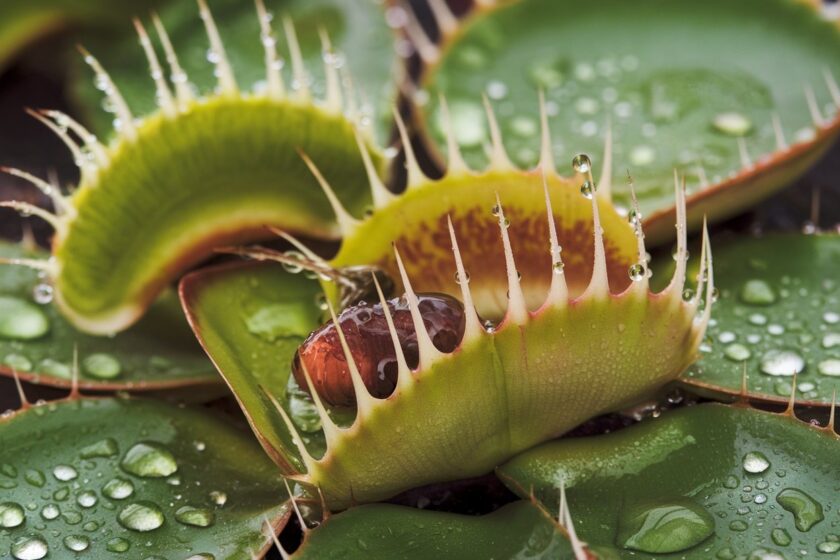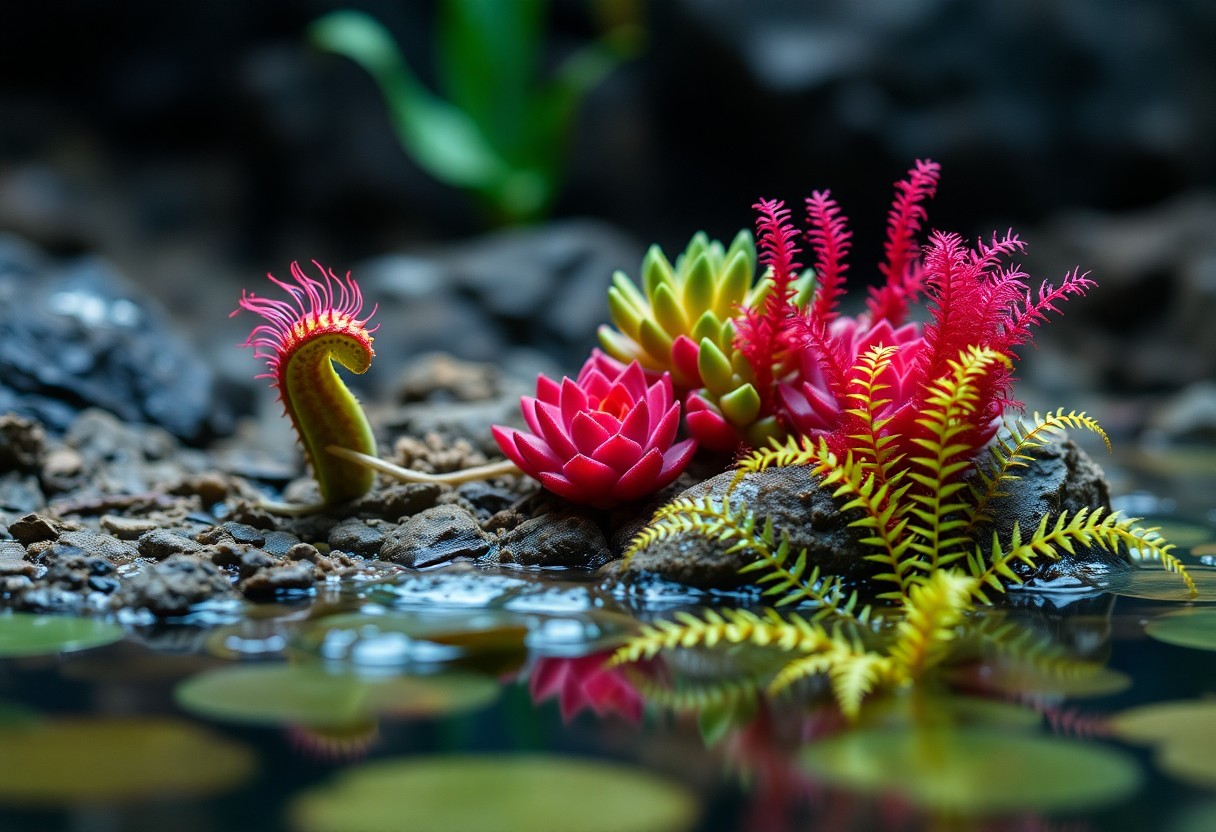With an astonishing array of survival strategies, plants have evolved remarkable adaptations that allow them to thrive in the most challenging environments. You might be surprised to learn how certain species use innovative tricks to conserve water, attract pollinators, or deter predators. In this post, you will explore some of the most fascinating plants and their extraordinary survival techniques, showcasing the resilience and ingenuity of the natural world.

The Queen of Survival: Succulents
While many plants struggle to survive in arid conditions, succulents excel in mastering the art of resilience. Their unique adaptations enable them to thrive in environments where water is scarce, making them a favourite choice for gardeners who appreciate hardy plants. You will find that their vibrant forms and colours can liven up any space while requiring minimal maintenance.
Water Storage Mechanisms
At the heart of a succulent’s survival lies its remarkable ability to store water. These plants have thick, fleshy leaves or stems that act as reservoirs, allowing them to absorb and retain moisture during periods of drought. This enables you to enjoy flourishing greenery even in the harshest conditions.
Environmental Adaptations
After adapting to their surroundings, succulents develop various strategies to cope with extreme climates. You will notice how their waxy coatings reduce water loss, while specialised stomata open mainly at night to minimise evaporation during the hot day. Such traits allow you to cultivate these intriguing plants in locations with demanding weather.
In fact, succulents often exhibit unique shapes and sizes tailored to their specific habitats. For instance, some may have a compact form to reduce surface area exposure to the sun, while others might develop deeper roots to reach underground moisture. These ingenious adaptations not only enhance their survival but also inspire you to appreciate the diverse strategies plants employ to thrive in often harsh and unforgiving environments.
Master of Camouflage: The Mimicry Plant
It is fascinating to see how certain plants have evolved remarkable mimicry techniques to survive in their environments. These plants have adapted to imitate various elements of their surroundings, providing them with enhanced protection against predators and environmental threats. By blending seamlessly with their surroundings, they ensure their survival while also captivating the curiosity of those who observe them.
Types of Mimicry in Flora
Across the botanical world, various types of mimicry can be observed among plants, each serving a unique purpose in their survival strategies.
| Mimicry Type | Description |
| Camouflage | Blending with the environment to avoid detection. |
| Batesian Mimicry | Imitating the appearance of toxic plants. |
| Bidirectional Mimicry | Looking like both the predator and prey. |
| Floral Mimicry | Resembling flowers to attract pollinators. |
| Fruiting Mimicry | Producing fruit-like structures to lure animals. |
Assume that each of these mimicry types plays an integral role in the survival of plants in their unique ecology.
Benefits of Mimicry for Survival
Behind every mimicry strategy lies a set of benefits that enhance a plant’s chances of survival. By imitating other flora or their surroundings, these plants can avoid herbivory, attract necessary pollinators, and sometimes even co-opt the behaviours of animals for their own advantage.
Indeed, the benefits of mimicry extend beyond mere camouflage. By effectively deceiving potential threats, plants can conserve energy and resources that would otherwise be spent defending themselves. Furthermore, some mimic plants attract beneficial pollinators, ensuring their reproductive success while simultaneously enhancing the biodiversity of their habitat. In a world where competition for resources is fierce, these survival tricks significantly improve their odds of thriving in challenging environments.
The Resilient: Fire-Adaptive Plants
Assuming you are intrigued by nature’s extraordinary adaptations, fire-adaptive plants exemplify resilience in the face of destruction. These plants have developed remarkable traits that allow them not only to survive but to thrive in environments prone to wildfires. With specialised strategies, they ensure their continuation and contribute to ecological recovery following fire events. As you explore their fascinating world, you will uncover how they embrace the flames for survival.
Survival Strategies Post-Fire
Against the odds, many fire-adaptive plants exhibit remarkable survival strategies after a fire. They often possess thick bark to shield vital tissues from high temperatures or produce prolific amounts of seeds that remain dormant until the right conditions arise post-fire. These adaptations are tailored to exploit the nutrient-rich environment that follows a blaze, ensuring that not only do they survive, but they flourish.
Seed Germination and Regeneration
Above the charred landscape, the germination of seeds is a breathtaking spectacle in the aftermath of a fire. Fire-adaptive plants generally have seeds that are triggered to germinate by the heat of the flames or by the chemical changes in the soil. This adaptability enables them to seize opportunities in a nutrient-dense environment, as the ashes provide imperative minerals and a reduced competition from other plants.
Due to their unique requirements, many fire-adaptive plants have seeds that are encased in hard outer shells, which need the intense heat of a fire to break down. This process not only encourages germination but enables the seeds to thrive in an environment free from other vegetation that was unable to withstand the flames. By strategically timing their regeneration, these plants establish themselves once again, ensuring continuity and contributing to the ecology of their habitat.

The Extreme Survivor: Halophytes
To thrive in environments where most plants would struggle, halophytes have developed impressive adaptations that allow them to flourish in saline conditions. These extraordinary plants can be found in coastal areas, marshes, and salt flats, showcasing an incredible ability to withstand high concentrations of salt in their surroundings. Their unique characteristics not only contribute to their survival but also play a significant role in maintaining the balance of their ecosystem.
Salt Tolerance Mechanisms
Between the various strategies employed by halophytes, some have developed specialized salt glands that excrete excess salt, while others compartmentalise salt within their tissues. This allows the plants to maintain osmotic balance and protect vital cellular functions, ensuring they can thrive in adverse conditions. Moreover, certain halophytes utilise the rapid uptake of potassium ions to counteract the toxic effects of sodium, optimising their growth even in saline environments.
Coastal Ecosystems and Their Importance
By supporting a diverse range of organisms, coastal ecosystems play a vital role in the health of our planet. These areas, often dominated by halophytes, provide critical habitat for many species, including birds and marine life, while also serving as buffers against erosion and flooding. Furthermore, they contribute to nutrient cycling and water filtration, enhancing the overall resilience of the environment.
It is crucial to understand that coastal ecosystems are not just vital for biodiversity; they also serve as nurseries for fish and shellfish, which are important for human livelihoods. The presence of halophytes stabilises sediment, protecting shorelines and reducing the impact of storm surges. By conserving these unique ecosystems, you help ensure the sustainability of natural resources that we all rely on, highlighting the interconnectedness between halophytes and the greater environment.
Masters of Desiccation: Resurrection Plants
Keep your eyes on resurrection plants, nature’s remarkable survivors that can withstand extreme dehydration. These incredible organisms possess the ability to enter a state of dormancy, effectively pausing their life processes until they encounter water again. You will find that their extraordinary adaptations enable them to thrive in some of the most arid environments on Earth.
Anhydrobiosis Explained
Below, you will discover the fascinating process of anhydrobiosis, where resurrection plants lose up to 95% of their water content and yet remain unscathed. During this process, their cells change structurally, altering their internal chemistry to protect against damage. When moisture returns, they rehydrate and resume their metabolic functions, showcasing a stunning ambition for survival.
Ecological Significance
At the heart of this topic is the ecological significance of resurrection plants, which play an important role in their ecosystems. By surviving prolonged droughts, these plants contribute to soil stabilisation and provide habitats for various organisms. Their ability to regenerate rapidly promotes biodiversity, ensuring that life continues even amidst challenging conditions.
This resilience not only aids in nutrient cycling but also supports other species during times of scarcity. By serving as a source of moisture and providing shade, resurrection plants enhance the microhabitats around them. Their survival strategies remind us of the delicate balance within ecosystems and the vital roles each organism plays in maintaining environmental health.

Innovative Defense: Carnivorous Plants
Once again, nature has astounded you with the fascinating adaptations of carnivorous plants. These extraordinary botanicals have evolved unique strategies to ensnare and digest unsuspecting prey, allowing them to thrive in nutrient-poor environments. Their ability to supplement their diet with insects and other small creatures demonstrates a remarkable form of innovation in survival tactics, showcasing the complexity of life on Earth.
Nutrient Acquisition Techniques
After exploring the mechanisms of carnivorous plants, you will find their nutrient acquisition techniques truly remarkable. With methods such as trapping, luring, and digesting prey, these plants have developed effective ways to compensate for the lack of nutrients in their habitats. From sticky tentacles to snap traps, each technique reflects a unique adaptation to capture their food efficiently.
Evolutionary Advantages
With the unique strategies developed by carnivorous plants, you realise that their evolutionary advantages are undeniable. These adaptations not only ensure their survival but also provide them an edge over other plants in nutrient-deficient environments. By capitalising on available resources, they can thrive where others struggle, highlighting the intricate balance of life in diverse ecosystems.
At the heart of these evolutionary advantages lies a sophisticated interplay between form and function. The specialised structures of carnivorous plants, such as leaves transformed into traps, enable them to effectively capture and digest prey. In doing so, they access vital nutrients that would otherwise be unavailable. This not only enhances their growth and reproduction but also permits them to occupy ecological niches that are inhospitable to non-carnivorous plants, reinforcing their role as important contributors to biodiversity.
Summing up
Drawing together the fascinating world of plants and their survival tricks, you can appreciate the incredible adaptations that allow them to thrive in various environments. From the carnivorous habits of the Venus flytrap to the water-storing capabilities of succulents, these remarkable strategies highlight the resilience and ingenuity of nature. By understanding their survival mechanisms, you gain insight into the delicate balance of ecosystems and the importance of biodiversity for our own survival. Embracing this knowledge can inspire you to appreciate the beauty and complexity of the natural world around you.

